The difficulty of initiating and
especially sustaining clean overbends on certain brands and models of
diatonics--especially Asian-made ones like Lee Oskars, Suzukis and Huangs--has meant that
if you played those harps, you effectively had to forgo learning to really play overbends.
The world of cutting-edge diatonic harp has been dominated by the Hohner handmade
series
reedplate, particularly in customized form, because they do overbends significantly
better. If you play something else, you're far behind the game. A
controversial fix for shrilling reed freakout was developed independently by several
people a few years ago and can be found in the Harp-L archives as the famous "wax
fix" thread. These people thought the base of the reed itself might be
vibrating at some higher overtone of the note, and stabilized the base by applying beeswax
or nail polish, but this never really caught on widely.
At the 2000 Harmonica Summit in Minneapolis, Turbo Dog (aka Dr. James Antaki) tackled the
problem of shrilling reed freakout almost as an aside during a discussion of reed/mouth
physics. He said harps like LOs suffer from a torsional oscillation of the reed
under stress, and that this oscillation could be damped out by applying a small square of
tape to the center of the reed's "downwind" side, according to his initial
tests. The theoretical basis for this fix was originally aerodynamic in nature;
everyone's seen the famous footage of the Tacoma Narrows bridge in high winds, twisting
like a rubber band. Turbotape is related to what bridge designers developed to
prevent that situation.
The method is simply to place a small square of adhesive tape at the center of the reed.
Shape is important--square or nearly square does seem to work best. And size
does matter; naturally it needs to be small enough that it doesn't overhang the edges of
the reed and contact the reedslot. So a square that is slightly narrower than the
width of the reed is what to aim for. Too small a piece of tape will reduce the
desired effect, while too large a piece--say, a large rectangle--does not help noticeably,
though it is
sometimes unavoidable when you're trying to cut tiny squares.
Any adhesive tape that can be cut to the proper size will work. My favorite is a
1.5mm wide graphic art tape from the art supply store that is easier to cut into 1.5mm
squares. If you use a tape that is this narrow, you only have to make a single cut
to prepare a piece of Turbotape. I wrap several centimeters of tape onto an empty
white plastic pill bottle and leave it there, cutting off pieces as needed The
graphic design tape is not terribly easy to cut because the backing is a soft vinylish
material and the adhesive itself is fairly thick, but only having to cut it in one
direction helps. The adhesive does lend itself to repositioning the tape square on the
reed if needed, but stays put when you want it to. Be sure to cut as cleanly as
possible on any kind of tape, so that you do not have small frayed ends dangling off that
could jam the reedslot.
Turbo Dog's aerodynamic theory indicated that the tape should be placed on the
"downwind" or convex side of the reed, nearest to the reedplate. This
complicates installation on the draw plate quite a bit, and means that if you forget about
the tape when you regap a draw reed, you can dislodge the tape square and complicate your
life still more. Fortunately, installing the draw reed tape on the
"outside" still seems to work well at quelling reed squeal, so you don't even
have to take your harp apart to install the stuff. Using the standard #11 X-Acto
knife blade to do your cutting gives you a handy tool for placing the tape square onto the
reed; use it along with something like a toothpick to stick the tape to the reed, pull the
knife blade free, and use the tip of the blade to perfect the tape's position. The
LO toolkit "gapping pick" is very useful for smoothing down the tape with the
outside of its hook end, but as always you can improvise your own tools.
Turbotape has been applied with success on Lee Oskars, Huang Star Performers and
Silvertone Deluxes, Suzuki ProMasters and BluesMasters, Bushmans, and Hohner MS series
reeds. It even helps to stabilize Hohner handmade series and Hering Blues reeds.
We put tape on both reeds in a hole of the Asian-made harps, which can be done without
removing the reedplates. This can be done with Hohner handmades or Hering Blues as
well, but we have also had success stabilizing overbends on these reedplates by taping
only the closing reed involved (1-6B, 7-10D).
Turbotape indisputably stabilizes overbends, but there is disagreement as to whether it
can help in initiating them. As a less experienced overbender, I found Turbotape to
help in initiating overbends, even making previously impossible overbends attainable
without modifying the reed offsets. But it had to be an overbend that was already
trying to happen. In this sense, Turbotape can help overbends succeed at wider
("non-overblow") gapping, especially in conjunction with reedwork like
embossing.
Proficient overbenders will find much more stable OBs, if no more ease in initiating them;
these players are already good at starting the note, but can use the easier sustain that
Turbotape provides. Carlos del Junco tested a Turbotape-equipped harp on tour late
last year, and came home convinced that the increased sustain made it worth learning to
apply.
Some people are using Turbotape in conjunction with the wax/nail polish reed base
treatment, finding that this improves different aspects of the overbend and gives them
maximum control.
Drawbacks? Putting Turbotape on requires a little patience and precision, as do all
operations on the reeds themselves. The tape may well dull the reed's tone ever so
slightly, but users are in firm agreement that the improvement in overbending far
outweighs a virtually imperceptible change in tone, especially when you are talking about
harps that wouldn't really overbend without Turbotape. Some are using it
mainly to enhance overdraws on holes 7-10, where a slight decrease in high frequencies is
less noticeable. However, one thing to watch for is that the tape's weight can drop the
reed's pitch by a cent or two, particularly on the higher reeds, so you may want to tune
carefully after applying the stuff.
I have focused mainly on overbends, but Turbotape also stabilizes bends like the 3Dbbb
that can be difficult on higher-keyed LOs, and can let you sustain something like a 10Bbb
that otherwise might get away from you on any harp. It can extend your effective range on
all kinds of bends. It even makes valved bends more sustainable than ever before.
People are now experimenting with using other materials at the reed center in search of
the same effect. Brendan Power recommends Blutak brand synthetic putty as something
which both sticks to the reed reliably and is removable as well.
In any case, Turbotape clearly improves the stability of overbent notes and can help
anyone get more out of their favorite model of diatonic harp. We're all indebted to
Dr. Antaki for this technique.
My thanks to Pete Elder for helping beta test Turbotape, and also to
those Harp-L'ers who have posted their results--Stephen Schneider
|
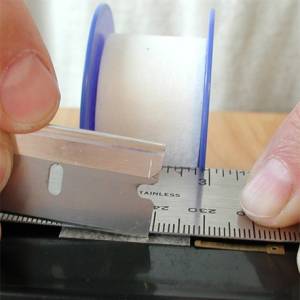 |
| Cut
a strip of micropore (or of any adhesive tape)
The micropore is cut on plane
desk. The reed serves as a size reference
|
|
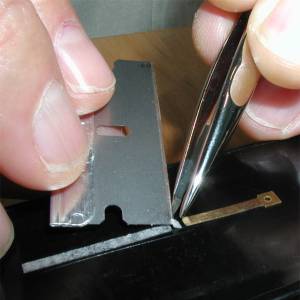 |
| Cut
an get a square of Micropore
Get the square by using tweezers
and a razor blade
|
|
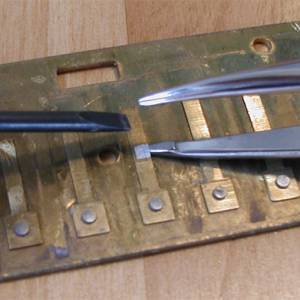 |
|
Apply the square in the middle of a blow
reed after having dismounted the reedplates
Use the tweezers to apply the Micropore square
and a little screwdriver to make it adhere
|
|
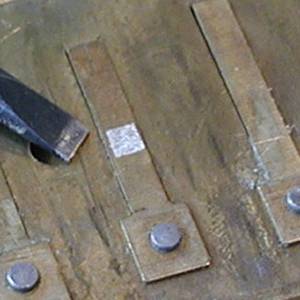 |
| Result
The Micropore Square has been applied
|
|
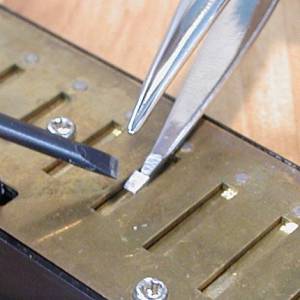 |
| Apply
the square in the middle of a blow reed without having
dismounted the reedplates
Use the tweezers to apply the Micropore square and a
little screwdriver to make it adhere
|
|
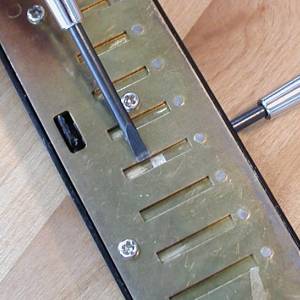 |
| Final
touch
In order to make adhere the square, stabilize
the reed thanks to a little screwdriver and press
the square with another little screwdriver
|
|
|